Notes: Castle Bromwich station was located on the Birmingham & Derby Junction Railway (B&DJR) Tame valley line that opened as a double-track route between Water Orton and Birmingham Lawley Street on 10 February 1842. The B&DJR opened a railway between Derby and a junction with the London & Birmingham Railway (L&B) at Hampton in Arden on 12 August 1839. From Hampton the B&DJR trains had to travel over the L&B to reach Birmingham, which caused considerable expense. The Tame valley line gave the B&DJR their own route into the city where they opened their own terminus at Lawley Street.
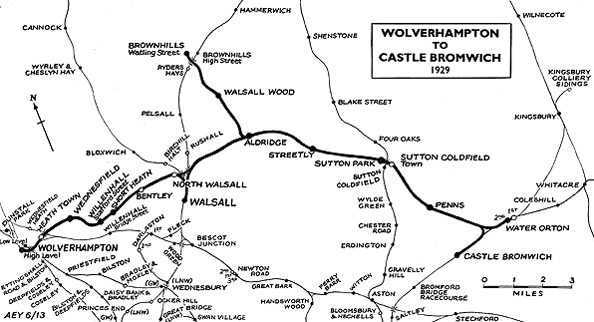
Castle Bromwich was located on the east side of Chester Road which passed over the line to the south of the station’s namesake. The station was provided with two platforms and had its main facilities on the south side of the line on the down platform; waiting facilities were also provided on the up platform.
Castle Bromwich had goods facilities in the form of a siding located to the rear of the down platform. A signal box located at the east end of the up platform controlled the main line through the station and movements into and out of the goods siding.
On 10 May 1844 the B&DJR merged with a number of other companies to form the Midland Railway (MR).
The March 1850 timetable showed Castle Bromwich as having three trains to Derby and four to Birmingham Lawley street Monday-to-Saturday. On Sundays no trains called at the station.
On 1 May 1851 the MR closed its Lawley Street station and started to use a new joint station with the London & North Western Railway (LNWR) at Birmingham New Street. The LNWR had been formed out of the L&B and a number of other companies.
On 1 July 1879 Castle Bromwich began to be served by trains running between Birmingham New Street and Wolverhampton via Sutton Park. The MR had opened a line from a point just under a mile to the east of Castle Bromwich to Walsall.
The Tame valley line became a very busy main line of the MR and handled large amounts of freight as well as passenger traffic. The December 1895 timetable showed Castle Bromwich as having nineteen up and twenty-three down trains on Monday-to-Saturday and non on Sundays. Eleven of the trains in each direction ran between Birmingham and Wolverhampton.
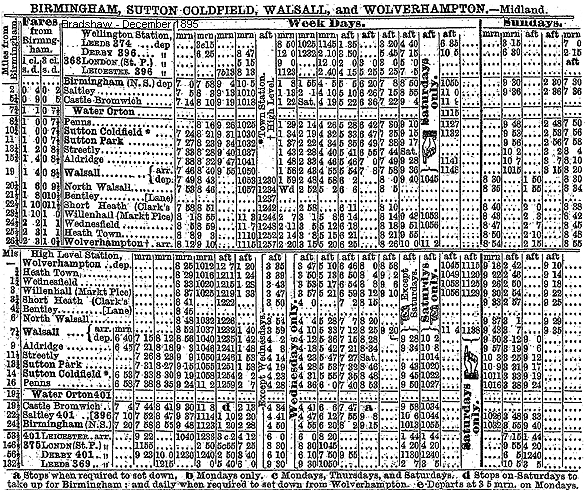 |
So busy had the Tame valley line become by the end of the nineteenth century that the MR quadrupled it through Castle Bromwich. The works required a complete remodelling of the station. In its new form Castle Bromwich had its entrance on the east side of Chester Road and south of the road bridge over the railway. The two-storey building had its upper storey at road level. Although brick-built there were occasional terra-cotta courses to add some fashionable distinction. The ridge of the roof was parallel to the road and ended with two tall chimneystacks which were treated to terra-cotta courses. The road frontage looked unbalanced with a large gable, topped with a ball finial, facing the road towards its southern end and pierced by an oeil-de-boeuf window; a much smaller but more elaborately designed gable, with a similar window and a ball finial, was found towards the northern end. A verandah was clasped between wing walls at each end of the building which were capped by remarkably large ball finials. The building was entered via a triple arcade. The two storeys viewed from the platform elevation were less elaborate, but not without interest. Two asymmetrically placed gables projected a short distance from the structure, one with a tall chimneystack springing from it. Openings on this elevation were a mixture of complete and segmental arches.
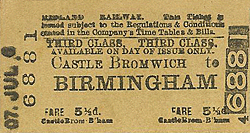 The booking office was by the main entrance. Passengers then went onto a covered footbridge that passed over four lines. The southernmost line was the down goods, and to the north of it a set of steps, also covered, led down to the down (Birmingham direction) platform. It was an island platform but with only one face, which served the down main line. It had its back to the down goods line, and railings prevented passengers from getting onto it. The booking office was by the main entrance. Passengers then went onto a covered footbridge that passed over four lines. The southernmost line was the down goods, and to the north of it a set of steps, also covered, led down to the down (Birmingham direction) platform. It was an island platform but with only one face, which served the down main line. It had its back to the down goods line, and railings prevented passengers from getting onto it.
Directly opposite the down platform was the up (Derby direction) platform. It was also reached by a set of covered stars from the footbridge. In common with the down platform a line also passed behind it, the up goods line. It also had railings to the rear keeping passengers off the goods line.
The down platform was numbered 1 and the up 2. Both platforms were provided with timber-framed buildings with vertical board infill and large, rather ungainly, cantilevered canopies. These were definitely poor relations in comparison to the elaborate entrance building.
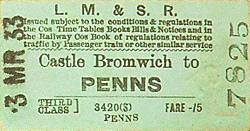 There was a further platform at Castle Bromwich located on the north side of the station north of the up goods line onto which it backed. It was reached by uncovered steps that led down from the northern end of the footbridge. The line it served diverged from the main line and ended at a buffer stop adjacent to the Chester Road bridge; it was numbered 3 and used by excursion services. There was a further platform at Castle Bromwich located on the north side of the station north of the up goods line onto which it backed. It was reached by uncovered steps that led down from the northern end of the footbridge. The line it served diverged from the main line and ended at a buffer stop adjacent to the Chester Road bridge; it was numbered 3 and used by excursion services.
The goods facilities were expanded to include two sidings directly behind the main station building. At ground level the building had goods offices. A new signal box was provided on the south side of the line further east than the original.
In 1920 an exhibition centre for the British Industries Fair opened on the north side of the line. From that year until 1960 (with the exception of 1925 and the period 1941 to 1946) exhibitions lasting two weeks were held every year. Thousands travelled to the fairs by train and special excursions were run making Castle Bromwich very busy.
By July 1922 Castle Bromwich station was being served by twenty-two up and nineteen down trains Monday-to-Saturday. No trains called at the station on Sundays.
| Up Trains July 1922 |
Destination |
Down Trains July 1922 |
Destination |
| 7.34am |
Wolverhampton |
7.39pm |
Birmingham New Street |
| 7.39am |
Leicester |
8.02pm |
Birmingham New Street |
| 7.49am |
Nuneaton |
8.17am |
Birmingham New Street |
| 7.58am |
Derby |
8.43am |
Birmingham New Street |
| 8.20am |
Wolverhampton |
9.31am |
Birmingham New Street |
| 8.39am |
Derby |
9.55am |
Birmingham New Street |
| 10.48am |
Leicester |
10.40am |
Birmingham New Street |
| 10.56am |
Wolverhampton |
10.49am |
Birmingham New Street |
| 1.19pm |
Leicester |
12.27pm |
Birmingham New Street |
| 1.24pm |
Wolverhampton |
1.29pm |
Birmingham New Street |
| 1.32pm |
Derby |
3.05pm |
Birmingham New Street |
| 2.52pm |
Nuneaton |
4.52pm |
Birmingham New Street |
| 3.52pm |
Burton-on-Trent |
5.40pm |
Birmingham New Street |
| 4.19pm |
Wolverhampton |
6.20pm |
Birmingham New Street |
| 4.50pm |
Derby |
7.06pm |
Birmingham New Street |
| 5.43pm |
Wolverhampton |
8.19pm |
Birmingham New Street |
| 6.18pm |
Leicester |
8.37pm |
Birmingham New Street |
| 6.42pm |
Wolverhampton |
9.02pm |
Birmingham New Street |
| 7.28pm |
Wolverhampton |
10.22pm |
Birmingham New Street |
| 9.03pm |
Derby |
|
|
| 9.24pm |
Wolverhampton |
|
|
| 11.01pm |
Walsall |
|
|
On 1 January 1923 the MR was absorbed into the London, Midland & Scottish Railway (LMS). Little would have changed, and the route through Castle Bromwich continued to be a busy main line.
At Nationalisation on 1 January 1948 Castle Bromwich became part of British Railways (London Midland Region). The summer 1948 timetable showed twenty-three up and sixteen down trains Monday-to-Friday. There were extra services on Saturdays and two trains in each direction on Sundays.
For the British Industries Fair of 1956 new DMUs were used on a shuttle service between Birmingham New Street and Castle Bromwich to carry visitors to the event. The BR timetable for the winter of that year showed twenty-two up and twenty-one down services Monday-to-Friday with a couple of extra trains on Saturdays.
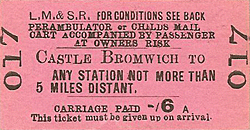 The Reshaping of British Railways (‘Beeching’) report of 1963 recommended the withdrawal of all stopping services between Birmingham and Derby and the closure of the stations at which they called. Despite the identification of this route for closure Castle Bromwich was, surprisingly, not named in the list of stations to be closed. The summer 1962 timetable showed that the station had a good service of thirty-two upand twenty-eight down trains Monday-to-Friday; it served a large residential area close to the centre of Birmingham. The Reshaping of British Railways (‘Beeching’) report of 1963 recommended the withdrawal of all stopping services between Birmingham and Derby and the closure of the stations at which they called. Despite the identification of this route for closure Castle Bromwich was, surprisingly, not named in the list of stations to be closed. The summer 1962 timetable showed that the station had a good service of thirty-two upand twenty-eight down trains Monday-to-Friday; it served a large residential area close to the centre of Birmingham.
The Major Trunk Routes for Development report of 1964 (follow up to the Reshaping of British Railways) recognised the importance of the Tame valley line as part of a north-east and south-west trunk route, and it was recommended for retention and improvement. On 9 September 1964 formal notice was published of the proposal to withdraw Derby – Tamworth – Birmingham local trains, but it took until 16 August 1967 for Barbara Castle, Secretary of State for Transport to give her approval, reprieving one of the stations. Castle Bromwich closed to passenger services on 4 March 1968.
After closure the main building and the up and down platforms were demolished some years later. A section of the excursion platform 3 remained in situ in May 2013. The Tame valley line was still carrying large volumes of freight and passenger traffic at that time.
Tickets from Michael Stewart, timetable from Chris Totty and route map by Alan Young.
Sources:
To see other stations on the Castle Bromwich and Wolverhampton line click on the station name: Penns, Sutton Coldfield Town, Sutton Park, Streetly, Aldridge, North Walsall, Bentley, Short Heath,Willenhall Stafford Street,
Wednesfield and Heath Town
See also Brownhill branch stations: Walsall Wood and Brownhills
|

bromwich.jpg)
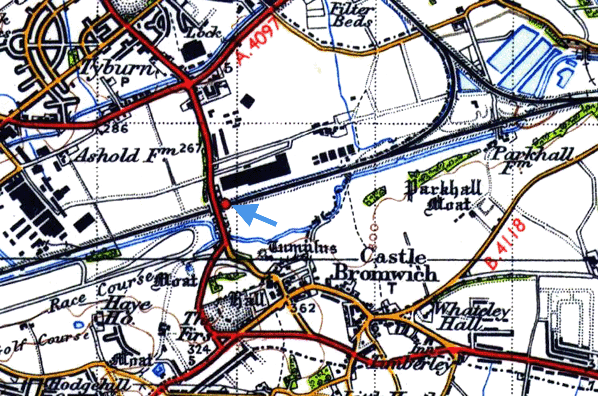
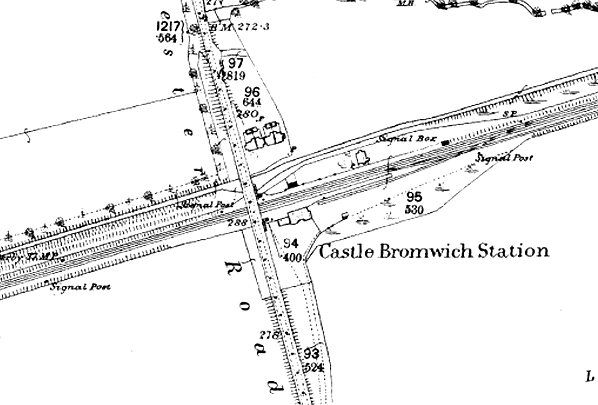
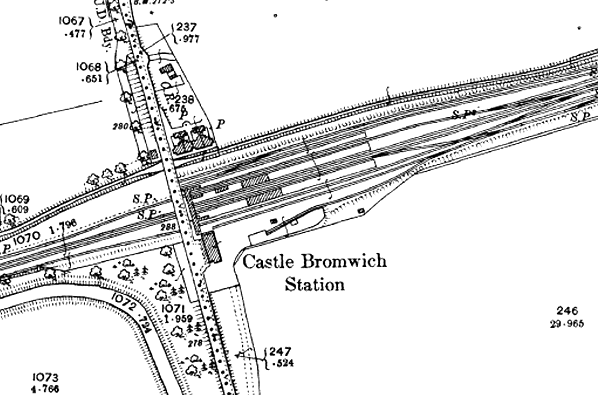
bromwich.jpg)
bromwich.jpg)
bromwich.jpg)
bromwich.jpg)
bromwich.jpg)
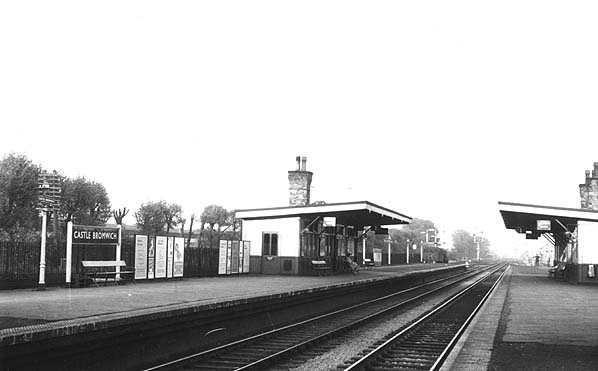
bromwich.jpg)
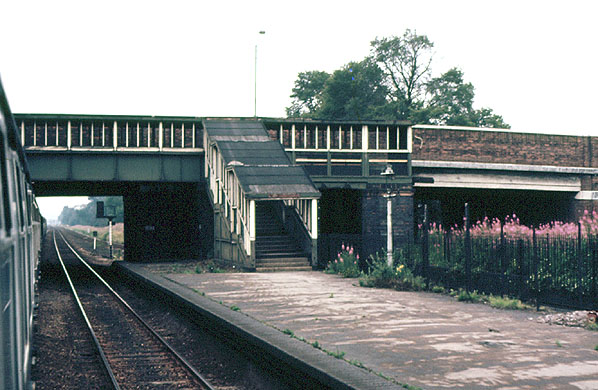
bromwich.jpg)
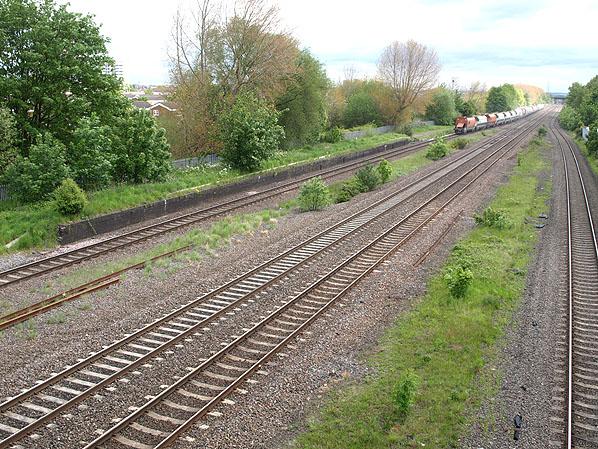


 The booking office was by the main entrance. Passengers then went onto a covered footbridge that passed over four lines. The southernmost line was the down goods, and to the north of it a set of steps, also covered, led down to the down (Birmingham direction) platform. It was an island platform but with only one face, which served the down main line. It had its back to the down goods line, and railings prevented passengers from getting onto it.
The booking office was by the main entrance. Passengers then went onto a covered footbridge that passed over four lines. The southernmost line was the down goods, and to the north of it a set of steps, also covered, led down to the down (Birmingham direction) platform. It was an island platform but with only one face, which served the down main line. It had its back to the down goods line, and railings prevented passengers from getting onto it.  There was a further platform at Castle Bromwich located on the north side of the station north of the up goods line onto which it backed. It was reached by uncovered steps that led down from the northern end of the footbridge. The line it served diverged from the main line and ended at a buffer stop adjacent to the Chester Road bridge; it was numbered 3 and used by excursion services.
There was a further platform at Castle Bromwich located on the north side of the station north of the up goods line onto which it backed. It was reached by uncovered steps that led down from the northern end of the footbridge. The line it served diverged from the main line and ended at a buffer stop adjacent to the Chester Road bridge; it was numbered 3 and used by excursion services. The Reshaping of British Railways (‘Beeching’) report of 1963 recommended the withdrawal of all stopping services between Birmingham and Derby and the closure of the stations at which they called. Despite the identification of this route for closure Castle Bromwich was, surprisingly, not named in the list of stations to be closed. The summer 1962 timetable showed that the station had a good service of thirty-two upand twenty-eight down trains Monday-to-Friday; it served a large residential area close to the centre of Birmingham.
The Reshaping of British Railways (‘Beeching’) report of 1963 recommended the withdrawal of all stopping services between Birmingham and Derby and the closure of the stations at which they called. Despite the identification of this route for closure Castle Bromwich was, surprisingly, not named in the list of stations to be closed. The summer 1962 timetable showed that the station had a good service of thirty-two upand twenty-eight down trains Monday-to-Friday; it served a large residential area close to the centre of Birmingham.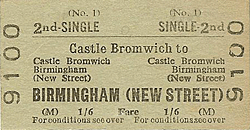
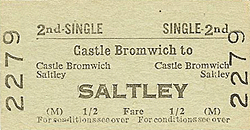

 Home Page
Home Page